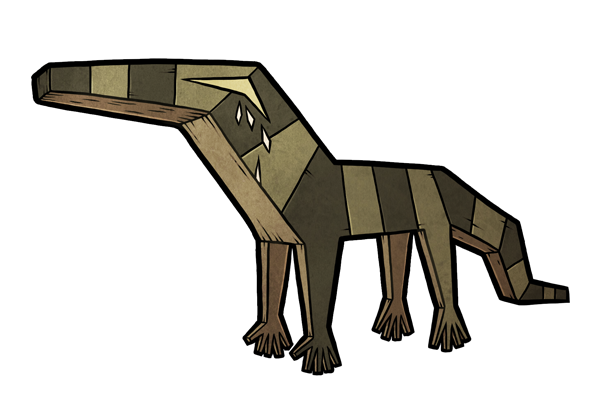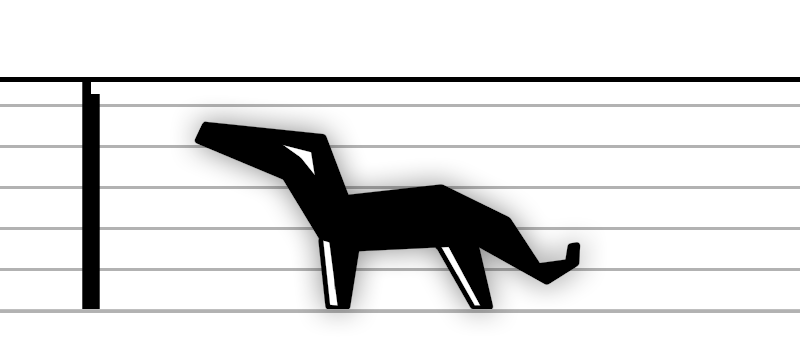

murodroze
the slow nights
prefix muro suffix droze
duranmna duranmni
physical appearance
The murodroze /ˈmjʊɹədɹəʊz/ is a dark brown stranger with a simple, geometric shape. Its solid body is composed of a wood-like substance, which, at first glance, appears identical to natural lumber, although it lacks either DNA or any cellular structure. The murodroze is textured to the touch, and can cause splinters when rubbed firmly. Its eye markings appear carved into its surface, with similar lines appearing between its stripes (which appear to be stained different colors). Its body rests on its fingertips, which are denser and more sturdy than the rest of its body. It smells strongly of oily wood, with a slightly burnt smell manifesting in 37% of individuals.
The murodroze's body behaves like normal wood when exposed to heat, cold, or moisture, and is thus prone to warping, cracking, and decay. Its body is not particularly flammable, however, and must be exposed to fire for at least an hour before it starts to burn (at which point it burns normally). The strain possesses no regenerative ability.
The murodroze speaks only through a long creaking sound that emanates from its general vicinity, and does not seem to come from within the murodroze's body. Its communication tends to be limited grinding, groaning, and scraping sounds.
the strained rasping of wood against wood.

environment and generation
The murodroze appears in a wide range of environments, but is most likely to appear in interior spaces, generating outdoors only 0.7% of the time. Attics, basements, and back rooms are frequent homes to a murodroze, as are long-abandoned warehouses, garages, and certain sheds and outbuildings. It is more likely to appear in dimly lit rooms, and seems to prefer either musty, dusty, or damp areas.
When it first appears, it starts off as a pile of sawdust and splinters, which grow together to form the murodroze's body over a period of two to four minutes, starting at the feet and working their way up. A majority of murodroze (79% of individuals) form upright, while 21% form on their side.
The murodroze is equally likely to generate alone or in groups. Groups of murodroze appear in random arrangements, and only rarely appear in ordered linear or circular formations. In addition, the murodroze is "stillborn" 0.6% of the time – these individuals decay upon generation, crumbling apart into soggy, rotten chunks after several minutes.
behaviour and effects
The murodroze possesses a leaden disposition. It normally stands completely still, and (if upright) scrapes forward a few inches only at highly irregular intervals. When it moves, its heavy body leaves behind deep scratches on the floor or ground beneath it. Although the murodroze is capable of speech, this behaviour is not common, and an individual may emit only one such outburst over the course of its life. Otherwise, the murodroze is predominantly inanimate, and has no particular influence on its surroundings.
interactions with sensitives
The murodroze is drawn towards sensitives as though pulled forward by a magnet placed beneath the floor. In addition, any toppled individual immediately rights itself with no difficulty once a sensitive approaches. The murodroze moves forward at a steady pace, just slower than average human walking speed. It moves only in straight lines, and rotates slowly between forward movements to readjust its trajectory. It cannot navigate around objects which form a barrier between the sensitive and itself, either pushing these obstacles over (in the case of boxes or furniture), or stopping entirely (in the case of walls or heavy objects, such as cast iron troughs).
Groups of murodroze follow sensitives together, a behaviour which sometimes causes their bodies to become jammed in place when several individuals attempt to fit through a tight space, such as a door or hallway.
The murodroze never touches a sensitive it follows, and instead stops just inches from the sensitive's body. It tends to place itself in such a way as to impede the sensitive's path, however, and thus force physical contact.
Physical contact with the murodroze generates small wood splinters in the lung tissue of the individual touching the murodroze. These splinters generate slowly, but even brief contact has a lasting effect, as the presence of these fibers poses significant health risks. Prolonged contact causes the lungs to become entirely filled with splinters, and after several minutes, those who touch the murodroze begin to experience severe shortness of breath, and eventually, asphyxiation. A minority of murodroze (2.3% of individuals) also cause splinters to generate in other body cavities and crevasses, such as between the teeth, beneath the eyelids, and within the nasal cavity.
The murodroze's body resists outside force, and it cannot be moved or pushed over while alive. It displays no reaction towards a sensitive's behaviours towards it, and does not move away from attack. Aside from its following of sensitives, it displays no other actions.Ɑ
Ɑ Chest-chess pieces.
aging and death
At the end of its life, the murodroze becomes fully inanimate, with no outward visual distinction able to be made between a living and dead murodroze, and with its death unmarked by any special behaviour or event. Its corpse does not show the resistance to force that characterizes a living murodroze, and can be pushed over or moved with no detrimental effects. Its body, which retains its structural similarity to wood, remains in place for anywhere from several months to several decades, but always eventually decomposes.



